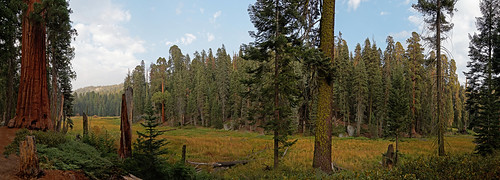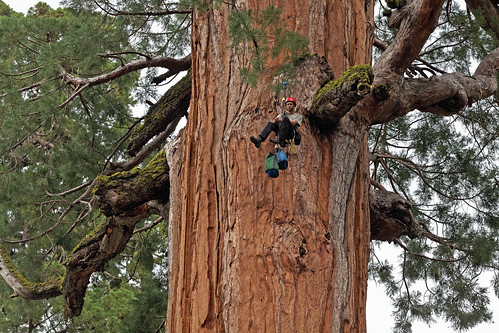
U.C. Berkeley biologists Cameron Williams and Rikke Naesborg measure the trunk diameter of a giant sequoia in Giant Forest, Sequoia National Park. Photo credit: Anthony R. Ambrose
“A mature Giant Sequoia can use 500-800 gallons of water every day during the summer,” saidAnthony Ambrose, a tree biologist at U.C. Berkeley. “That’s a lot of water necessary for just one tree.”
For the first time in at least 125 years, Giant Sequoias in the southern Sierra Nevada Mountains of California are showing significant amounts of “dieback” in their foliage due to several years of drought.
The U.S. Forest Service contributed emergency funding to a collaborative research project involving scientists from U.C. Berkeley, Sequoia and Kings Canyon National Parks, U.S. Geological Survey, andCarnegie Airborne Observatory to examine the effects of the current historic drought on Giant Sequoias.
If they get adequate water and nutrients, Giant Sequoias can live to be well over 3,000 years. They are the largest single-stem tree species in the world, with respect to wood volume and mass, and they grow best in a climate of snowy winters and dry summers. A big decline in snow pack in California over the last few years is a major reason for the observed dieback.

Log meadow in Giant Forest, Sequoia National Park. Photo credit: Anthony R. Ambrose
“What’s happening above ground is only half the picture,” noted Ambrose, one of the lead scientists on the project. He wants a much better handle on how below-ground conditions correlate with what they see above ground. For example, scientists do not yet know why a tree near a wet meadow can show dieback while a tree on dry ridgetop looks green and healthy.
Ambrose and his colleagues intend to construct a “vulnerability map” for the Giant Sequoias using a combination of traditional ground-based monitoring and data collected aerially by the Carnegie Airborne Observatory. The map will reveal which stands of trees are the most susceptible to drought conditions, allowing managers to prioritize those stands most in need of prescribed fire, mechanical thinning, or other treatments.
Prescribed fire is the most cost-effective way to remove brush and tree species that compete against the Giant Sequoias for limited water and soil nutrients; the sequoias’ thick bark protects them from fire while species that grow in their shade, such as white fir, go up in flames. Irrigation is another potential management tactic, although practical constraints will necessarily limit its application to small isolated areas.
“Obviously, given the water needs of Giant Sequoias, we cannot water an entire forest during periods of extended drought,” Ambrose said.
NOTE: For an interactive look at USDA’s work in conservation and forestry over the course of this Administration, visit http://medium.com/usda-results.

U.C. Berkeley biologist Cameron Williams ascends a giant sequoia to collect leaf samples in Giant Forest, Sequoia National Park. Photo credit: Anthony R. Ambrose
No comments:
Post a Comment
Note: Only a member of this blog may post a comment.